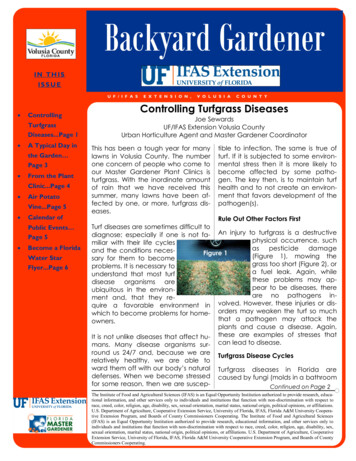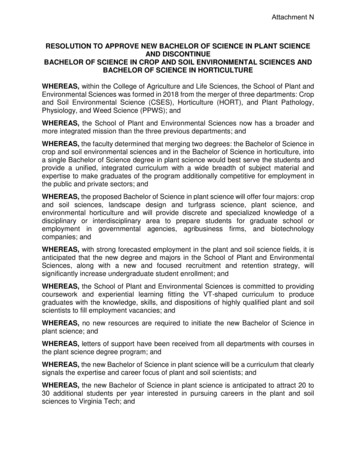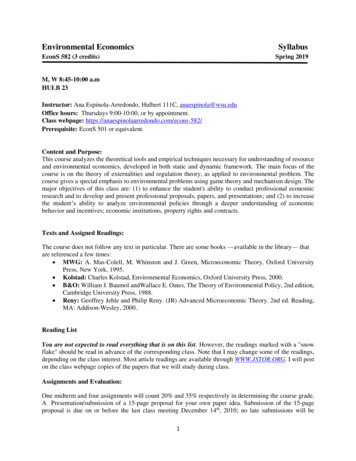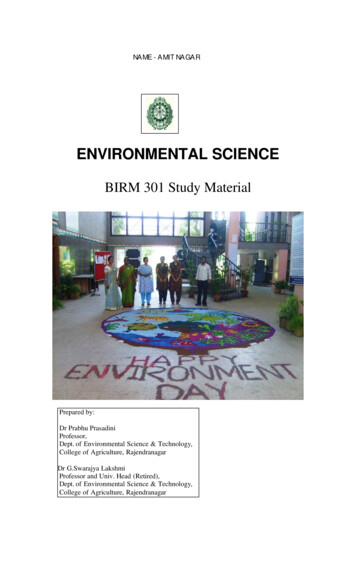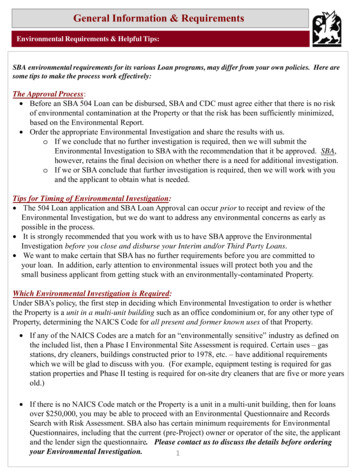
Transcription
Turfgrass and EnvironmentalResearch Online.Using Science to Benefit GolfIn its first 22 years, the buffalograss breeding program at UNL has been quite successful,releasing nine cultivars that have returned well over 1 million in royalties to UNL and theUSGA, and training 10 Ph.D. and 13 M.S. students. The success of this program has beena team effort involving faculty, staff and students in agronomy, entomology, biochemistry,biological engineering, horticulture, and plant pathology.Volume 5, Number 21November 1, 2006
PURPOSEThe purpose of USGA Turfgrass and Environmental Research Online is to effectively communicate the results ofresearch projects funded under USGA’s Turfgrass and Environmental Research Program to all who can benefitfrom such knowledge. Since 1983, the USGA has funded more than 290 projects at a cost of 25 million. The private, non-profit research program provides funding opportunities to university faculty interested in working on environmental and turf management problems affecting golf courses. The outstanding playing conditions of today’sgolf courses are a direct result of using science to benefit golf.EditorResearch DirectorJeff Nus, Ph.D.1032 Rogers PlaceLawrence, KS 66049jnus@usga.org(785) 832-2300(785) 832-9265 (fax)Michael P. Kenna, Ph.D.P.O. Box 2227Stillwater, OK 74076mkenna@usga.org(405) 743-3900(405) 743-3910 (fax)USGA Turfgrass and Environmental Research CommitteeSteve Smyers, ChairmanJulie Dionne, Ph.D.Ron DodsonKimberly Erusha, Ph.D.Ali Harivandi, Ph.D.Michael P. Kenna, Ph.D.Jeff Krans, Ph.D.Pete Landschoot, Ph.D.James MooreJeff Nus, Ph.D.Paul Rieke, Ph.D.James T. SnowClark Throssell, Ph.D.Pat Vittum, Ph.D.Scott Warnke, Ph.D.James Watson, Ph.D.Craig Weyandt, CGCSPermission to reproduce articles or material in the USGA Turfgrass and Environmental Research Online (ISSN 1541-0277) isgranted to newspapers, periodicals, and educational institutions (unless specifically noted otherwise). Credit must be given tothe author(s), the article title, and USGA Turfgrass and Environmental Research Online including issue and number. Copyrightprotection must be afforded. To reprint material in other media, written permission must be obtained fom the USGA. In anycase, neither articles nor other material may be copied or used for any advertising, promotion, or commercial purposes.
Buffalograss: Tough Native TurfgrassR.C. Shearman, T.P. Riordan, B.G. Abeyo, T.M. Heng-Moss, D.J. Lee,R.E. Gaussoin, O. Gulsen, H. Budak, and D. D. Serbaentered in to a joint project to develop buffalograss [Buchloe dactyloides (Nutt.) Engelm.] as aturfgrass species for potential use on golf courseroughs, fairways, and tees.In its first 22 years, the buffalograss breeding program at UNL has been quite successful,releasing nine cultivars (Table 1) that havereturned well over 1 million in royalties to UNLand the USGA, and training 11 Ph.D. and 14 M.S.students (Table 2). The success of this programhas been a team effort involving faculty, staff, andstudents in agronomy, entomology, biochemistry,biological engineering, horticulture, and plantpathology (27). The program was under the leadership of Terrance P. Riordan for nearly 18 years.It was under his leadership that the majority ofcultivar releases were made, and most of the students were trained. In 2002, a BuffalograssBreeding Program Working Group (Table 3) wasformed, and Robert C. Shearman took on the roleof working with this group and facilitating thebuffalograss breeding program.SUMMARYThe buffalograss breeding and genetics program at theUniversity of Nebraska-Lincoln began in 1984 with a goalto develop turf-type cultivars with the potential to conservewater and require reduced inputs of fertilizers, pesticides,and energy. In the past two decades, the buffalograssbreeding program at UNL has been quite successful.Among its accomplishments are:The release of five vegetative and four seeded cultivarswith improved turfgrass color, quality and performance.The training of 11 Ph.D. and 14 M.S. students in plantbreeding, genetics, and molecular genetics.The return of more than 1 million in royalties to UNLand the USGA.The acquisition of an extensive germplasm collectionthat varies in ploidy levels, is diverse geographically, andhas excellent turfgrass characteristics.The contribution to the fundamental understanding ofbuffalograss biology and genetics.In 1984, the United States Golf Association(USGA) Turfgrass and Environmental ResearchCommittee was interested in finding and developing turfgrasses that would meet the future needs ofthe golf course industry. They were particularlyinterested in grass species that would offer potential water conservation, and perform well withreduced inputs, such as fertilizers, pesticides, andenergy. With these goals in mind, the Universityof Nebraska-Lincoln (UNL) and the USGAR.C. SHEARMAN, Ph.D., Sunkist Fiesta Bowl Professor ofAgronomy; T.P. RIORDAN, Ph.D., Cyril Bish Professor ofHorticulture; B.G. ABEYO, Ph.D., Project Coordinator; T.M.HENG-MOSS, Ph.D., Associate Professor of Entomology,Department of Entomology; D.J. LEE, Ph.D., Professor ofAgronomy & Horticulture; R.E. GAUSSOIN, Ph.D., Professorand Extension Turfgrass Specialist; O. GULSEN, Ph.D., ResearchProject Director (Alata Horticultural Research Center, ErdemliMersin, Turkey); H. BUDAK, Ph.D., Assistant Professor ofMolecular Genetics (Sabanci University, Istanbul, Turkey); andand D.D. Serba, Graduate Research Assistant; Department ofAgronomy and Horticulture, University of Nebraska, Lincoln, NEUSGA Turfgrass and Environmental Research Online 5(21):1-13.TGIF Record Number: 117172Buffalograss is dioecious, having male (left) and female(right) plants. It is a native, perennial, low-growing, stoloniferous species that spreads rapidly and forms and excellentground cover. It withstands cold, heat, and drought stress,while maintaining its integrity as a sod forming turfgrassspecies1
-2000Year ReleasedPropagation tiveSeedPloidy idHexaploidHexaploidTetraploidHexaploidTable 1. Cultivars released by the University of Nebraksa Buffalograss Breeding Program since its inception in 1984Why Buffalograss?its ability to avoid drought and recover after longperiods of drought stress. Buffalograss has theability to go dormant sooner and revive morequickly than other turfgrasses under drought stressconditions. It can be established readily fromplugs, sprigs, sod, or seed. These characteristicsgive buffalograss an excellent potential for use asa turfgrass species, and were the reasons thatpiqued our interest for improving it for use as agolf course turfgrass species.Buffalograss is native to the NorthAmerican Great Plains, and is found naturallygrowing from central Mexico to Alberta, Canada,making it one of only a few native turfgrassspecies (33 ). It is a tough plant species known forit drought resistance, water conservation, hightemperature performance, winter hardiness, andlow maintenance characteristics.Buffalograss is a perennial, low-growing,stoloniferous species that spreads rapidly andforms an excellent ground cover. It withstandscold, heat, and drought stress, while maintainingits integrity as a sod forming turfgrass species. Inthe1930s, buffalograss was recognized as a grassspecies with considerable agricultural and conservation importance due to its surviving the combined effects of plowing, overgrazing, anddrought stress (3 ). Its dense sod-forming growthhabit made it a species that helped prevent windand water soil erosion, making it an ideal conservation species.Beard and Kim (2 ) demonstrated that buffalograss had an evapotranspiration rate that waslower than most warm- and cool-season turfgrasses. In most of our selection studies, we maintainbuffalograss germplasm with 25 mm (1 inch) ofwater per month, whether from rainfall, irrigation,or both. Its deep and extensive root system, relatively slow vertical canopy elongation rate, leafhairs, and leaf rolling characteristics contribute toWhat's the Breeding History for Buffalograss?The breeding and development history forbuffalograss is really recent history compared toother turfgrass and crop species. A study of buffalograss seed availability conducted about 60years ago found no commercially available cultivars (33). At that time, seed sources were harvested primarily from native buffalograss stands.The first described strain of buffalograsswas ‘Hays’ in 1950 (3 ). ‘Texoka’ buffalograsswas released in 1974, and was one of the firstimproved commercially available, cultivars (36).Its most significant attribute was its potentiallyhigh seed production rate. Until the 1980s, cultivar development was primarily for forage or conservation use. In the early 1980s, ‘SharpsImproved’, ‘Comanche’ and ‘W2F2’ werereleased. ‘Comanche’ and ‘W2F2’ are closelyrelated re-selections from ‘Texoka’.‘Prairie’ buffalograss was developed and2
Ph.D.Jeffrey KlingenbergJennifer Johnson-CicaleseCharles RodgersDan BeranShuizhang FeiKevin FrankTiffany Heng-MossOsman GulsenThomas Eickhoff †Songul Severmutlu †Desalegn Serba †M.S.Sarah BrowningDebbie SchwarzeJeana SvobodaRon MooreRob HiltonKatherine KernerMatt GieseKevin FrankTiffany Heng-MossTom EickhoffJeff CarstonsSongul SevermutluWyatt AndersonLuciana Toda †etative genotypes. Once a superior type is identified, sod, sprigs, or plugs can be used to increasethe cultivar. ‘Prairie’ was the result of thisapproach to buffalograss improvement.‘Bison’ buffalograss was released byOklahoma State University and the USDA-ARSin 1990 as a seeded cultivar (35). ‘Bison’ had agreater seed yield than ‘Texoka’, and was recognized for its forage, conservation, and general turfuse potential. ‘Bison’ was a four clone syntheticcultivar developed from two male and femaleclones which were selected plants in ‘Mesa’ and‘Texoka’ buffalograss stands. Synthetic cultivarstake advantage of additive gene response andaccumulation of favorable alleles in the new population to develop superior new lines (33). Mostrecent improvements in buffalograss have beenfor turfgrass rather than for forage or other 004---UNL Breeding and Development ProgramThe University of Nebraska-Lincolnreceived funding from the USGA in 1984 to support a buffalograss breeding and developmentprogram for golf course turf. Starting in 1984,WorkingGroup MemberArea ofExpertiseBob ShearmanFacilitatorBekele AbeyoProject CoordinatorFred BaxendaleEntomologyHikmet BudakMolecular BiologyRoch GaussoinWeed ScienceLoren GieslerPlant PathologyOsman GulsenMolecular BiologyTiffany Heng-MossEntomologyDon LeeGeneticsGautam SarathMolecular BiologyDesalegn SerbaBreedingSongul SevermutluPhysiologyPaul TwiggMolecular BiologyKen VogelBreeding and GeneticsLannie WitProject Management† Students currently working on their degree program.Table 2. Graduate students receiving degrees and trainingin the University of Nebraska-Lincoln Buffalograss BreedingProgram since 1984released in 1989 by Texas A & M University (10).It was the first cultivar released primarily for itsturfgrass characteristics. It was released as a vegetatively propagated cultivar that was sold as sod.It was recommended for use on minimal maintenance turfgrass sites like roadsides, industrialgrounds, parks and other non-irrigated turfs.Selection, hybridization, and clonal plant evaluation are approaches used to identify superior veg-Table 3. In 2002, a Buffalograss Breeding Program WorkingGroup was formed. Individuals and their areas of expertiseare listed above.3
Figure 1. Selection and evaluation are key components used by the University of Nebraska-Lincoln Buffalograss Breedingand Development Program to enhance germplasm development.growth habit; and mowing tolerance, sod strength,and sex expression.In 1991, ‘609’ buffalograss was released,and was the first buffalograss cultivar released byUNL as a result of support from the USGA (26).It was darker green and showed improved turfgrass quality compared to cultivars available atthat time. Recently, ‘609’ has been used as a standard cultivar in National Turfgrass EvaluationProgram (NTEP) trials for comparison with newreleases and experimental lines (Table 4). Resultsfrom NTEP trials demonstrated that ‘609’ was asouthern-adapted cultivar, having extended greencolor into the fall. In warm-season species likebuffalograss, this extended fall green response isoften associated with increased winter injury. In1993, ‘315’ buffalograss was released by UNL(28). It produces a fine textured, low-growingextensive collections of buffalograss germplasmwere made throughout the Central Great Plains(Figure 1). The emphasis for these plant collections was placed on ecotypes that expressed desirable turfgrass characteristics. At the same time,plant material from a Texas A & M University collection was obtained (27). This germplasm collection was planted in the field at the John SeatonAnderson Turfgrass Research Facility locatednear Mead, Nebraska. It was quickly identifiedthat many of the selections expressed desirableturfgrass characteristics. The following spring, 48genotypes expressing turfgrass characteristicswere planted in a replicated study for evaluation.These selections served as the first of severalselection and evaluation processes used to identify superior turfgrass types. Improvements concentrated on turfgrass quality, color, density and4
Entry378315BuffalawnNE 84-436Bowie (NTG-5)NTG-2AZ 143NTG-3609TatankaNTG-4PrairieHighlight 4NE 84-45-3Highlight 15Top GunSharps ImprovedHighlight 25PlainsTexokaRutgersBisonLSD5, 6). Thus, improvements in developing dense,low-growing, and dark green cultivars withextended growing seasons has been demonstrated.These improvements were particularly evidentwith the early vegetative releases from the UNLprogram.‘Tatanka’ was the first seeded release fromthe UNL Buffalograss Breeding Program. It wasreleased in 1995 through a cooperative effort withthe Native Turfgrass Group (20). ‘Tatanka’ was amaternal half-sib generated from a modified backcross of male selections on ‘315’, which was asingle female clone adapted to the northern GreatPlains. It demonstrated improved turfgrass quality, density, and leaf spot (Helminthosporium spp.)resistance when grown in central and northernportions of the range of adaptation for buffalograss.‘Tatanka’ showed promise as a seededturf-type, but was inconsistent in its seed yieldpotential and rate of establishment. Later it wasidentified that ‘Tatanka’ was a pentaploid (17).The unbalanced chromosome number likelyattributed to its poor seed production potential andlack of seedling vigor. This response identifiedthe importance of ploidy level to the enhancementof buffalograss breeding improvements. After therelease of ‘Tatanka’, ploidy level was determinedfor all genotypes making it to the advanced evaluation level in the program.‘Cody’ buffalograss was also released byUNL as a seeded type in 1995 (31). It was derivedfrom a four-clone synthetic consisting of two maleand two female clones, and was developedthrough cooperation with the Native TurfgrassGroup. These materials were selected from alarge heterogeneous population growing at theJohn Seaton Anderson Turfgrass ResearchFacility. These materials were obtained fromgermplasm collected from a broad geographicrepresentation. ‘Cody’ had similar turfgrass characteristics as ‘Tatanka’, but its seed yield andseedling vigor were much better than those identified for ‘Tatanka’. ‘Cody’ is a hexaploid.‘Legacy’ (i.e. 61) buffalograss wasreleased as a vegetative, turf-type buffalograss byUNL in 1997 (18). It is a dark green, low-grow-Mean Quality 94.94.84.84.84.84.80.2† Data are from the 1991 National TurfgrassEvaluation Program Buffalograss Trial 1991-1996Final Report.Table 4. Mean Turfgrass quality ratings of buffalograssentries grown at 28 locations in the USA. Turfgrass qualityratings are based on a 1 to 9 visual rating system with 1 poorest and 9 ideal. Data are a summary of those collected monthly from 1991 to 1995.attractive turf that tends to green up quicker in thespring, but goes dormant earlier in the fall thanmost other cultivars. The earlier fall dormancyexpressed by ‘315’ is associated with its improvedwinter hardiness compared to ‘609’. The cultivar‘315’is a northern-adapted selection. It had one ofthe highest mean quality ratings in the 1991 NTEPtrial final report (Table 4).Data demonstrate that turfgrass qualityimprovements have been made when compared to‘Texoka’ (base standard) and ‘609’ (improved,turf-type standard) in the past few years (Tables 4,5
Figure 2. ‘Prestige’ buffalograss, a recent release from the University of Nebraska-Lincoln Buffalograss Breeding Program,forms a dense turf at 15.6 mm moving height and 25 mm of water from rainfall, irrigation or both per month.ing, and very dense vegetative female clone withexcellent turfgrass quality (Tables 5, 6). It is noteworthy for its reduced canopy height and rapidlateral spread, making it an excellent turf-typebuffalograss. ‘Legacy’ is a hexaploid with centraland northern Great Plains adaptation. It has excellent winter hardiness.In 1997, ‘Prestige’ (i.e. 118) was alsoreleased by UNL (29). ‘Prestige’ is a tetraploid,vegetative cultivar that is lighter green than‘Legacy’, and tolerates mowing heights of 15.6mm (Figure 2). It has demonstrated an extendedgreen cover over the growing season by greeningup early in the spring, similar to ‘315’, and staying green longer in the fall. It also has demonstrated good winter hardiness, and is adapted foruse in southern to northern Great Plains.‘Prestige’ has excellent chinch bug (Blissusocciduus) resistance (12, 15).In 2001, UNL released ‘Bowie’, a seeded,turf-type buffalograss (32). This release wasmade in conjunction with the Native TurfgrassGroup. It is a four-clone synthetic with a widerange of adaptation and very good turfgrass quality characteristics (Table 4). ‘Bowie’ was comparable to ‘Tatanka’ and ‘609’ for turfgrass quality,but is darker green than either of those cultivars.It has very good bur yields, similar or better than‘Texoka’. ‘Bowie’ has excellent winter hardinessand excellent mealybug [Tridiscus sporoli(Cockerell) or Trionymus spp.] resistance (16).In 2005, the UNL program released ‘SWI2000’ in cooperation with Seeds WestIncorporated. ‘SWI-2000’ is an open-pollinatedvariety developed by three cycles of selection forheavier caryopsis weight in two elite experimentalgenotypes, ‘NE-501’, and ‘NE-503’. ‘NE-501’and ‘NE-503’ are both four-clone synthetics. The6
parent clones of these two genotypes were selected on the basis of multiple trait selection index,using turfgrass quality, bur yield, evapotranspiration, fall dormancy, false smut resistance, andseed set from a diverse collection of germplasmfrom the UNL collection. ‘SWI-2000’ has similarturfgrass performance characteristics as ‘Bowie’(Table 6), but has higher bur yield characteristics.Buffalograss is quite variable, and is a relatively easy species to improve using traditionalplant breeding techniques. Our research resultsindicate that cultivars can be developed withimproved turfgrass quality, color, and density, aswell as extended greenness and increased buryield potential. As water conservation continuesto become an issue for the turfgrass industry, buffalograss will become even more important and itsacceptance as a golf course turfgrass species willcontinue to nie BraeTexoka86-120609378UCR-95BisonMidgetStampedeLSD (0.05)C.V. (%)Adding to the Base Knowledge of BuffalograssGeneticsOur collection of buffalograss germplasmis a broad, genetically diverse resource with astrong potential for use in improving low-input,drought resistant golf course fairway, tee, andrough turfs. Our research has indicated thatsequence-related amplified polymorphism(SRAP) markers could be used to estimate genetic relationships among the genotypes in ourgermplasm collection (6, 8, 14). The use of PCRbased technologies is an effective approach forestimating genetic diversity, identifying uniquegenotypes, and for analyzing evolutionary andhistorical development of buffalograss as aspecies. Using these techniques, we have identified the depth and breadth of genetic diversity inour germplasm collection. Only a few genotypesin our germplasm collection were closely related(14). However, identifying these few closelyrelated genotypes helped us streamline our breeding, improve breeding efficiency, and avoid duplication of efforts.The implications of buffalograss evolutionare not clear. The center of origin for buffalograssis thought to be central Mexico. It is speculatedthat this population survived the ice age, and buffalograss spread across the Great Plains to its current southern and northern range of adaptation byherbivores feeding on its forage (23, 24). Thefemale flower is located in the sward canopy.These herbivores, primarily buffalo, subsequentlydispersed seed in their feces from burs that weredigested while eating the forage.Our evaluation of buffalograss evolutionrevealed that comparisons of sequence data fromthe mitochondrial and plastid genome suggestedthat all genotypes contained the same cytoplasmicorigin (7). Thus cytoplasmic incompatibility isnot an issue for buffalograss breeding programs.The buffalograss genome appears to have evolvedthrough the rearrangement of convergent subgenomic domains. The sequence informationobtained in these studies can be used as genomespecific markers for investigation of the buffalograss polyploidy complex, and testing of plastidMean Quality .1† Data are from the 1996 National TurfgrassEvaluation Program Buffalograss Trial 1996-2000Final Report.Table 5. Mean turfgrass quality ratings for buffalograssentries grown at 12 locations in the USA. Turfgrass qualityratings were based on a 1to 9 visual rating scale with 1 poorest and 9 best. Data were collected monthly from alllocations from 1996 to 2000.7
and mitochondrial mode of transmission in thegenus (5, 13).Peroxidase activity has been associatedwith chinch bug resistant (i.e. ‘Prestige’) and susceptible (i.e. ‘378’) buffalograss cultivars (12,15). Plant peroxidases are a family of related proteins possessing highly conserved domains.Degenerate oligonucleotide primers based onthese conserved domains can be used to amplifyDNA sequences coding for peroxidases, usingbuffalograsses with unsequenced genomes. Westudied polymorphisms of peroxidase genesamong buffalograss genotypes. We also investigated the potential evolutionary relationshipsamong the genotypes studied, using this approach.Targeted-PCR amplification of genomic DNAyielded polymorphisms that differentiateddiploids from polyploids within buffalograss.A total of 11 peroxidase gene fragments,seven belonging to buffalograss and four to theother grass species studied were sequenced duringthese studies. Five of these sequences were clustered with rice ascorbate peroxidases, which wereknown to have chloroplast origin. The resultsfrom these studies demonstrated that primers tar-EntryLegacyNE 95-55378BowieDensitySWI-2000BisonTexoka609Frontier TurfalloLSDCV (%)May † .74.06.06.36.02.02.01.516.4geting the peroxidase gene family could be usedto study genotypic diversity and evolutionary relationships within and between species. The PCRbased peroxidase markers may also have potentialfor use in linkage mapping and differential geneexpression studies in grasses.Recently, chinch bug (Blissus occiduus)has become an important insect pest of buffalograss in Nebraska (1, 12). Germplasm screeningconducted so far found considerable variationamong buffalograss genotypes, indicating thepresence of genetic resistance, tolerance, or bothto chinch bugs (12, 15). However, the mechanisms of resistance and their mode of inheritancehave not been determined. The insect resistancevariability observed did not show trends associated with ploidy level. Fortunately, this responsesuggests that any technology developed for thelower ploidy level buffalograss genotypes (i.e.diploids) should be applicable to the higher ploidylevel genotypes (i.e. tetraploids and hexaploids).To bring different desirable turfgrass quality traits into one genotypic background, it isimperative to understand the genetic basis of thetraits (19). Chinch bug resistance is an August September October .5† Data are from the 2000 National Turfgrass Evaluation Program Buffalograss Trial 2005 Progress Report.Table 6. Mean turfgrass quality ratings for buffalograss entries evaluated at the John Seaton Anderson Turfgrass ResearchFacility located near Mead, NE. Turfgrass quality ratings were based on a 1 to 9 visual rating scale with 1 poorest and 9 best. Data were collected monthly during the 2005 growing season.8
trait for buffalograss turf. Resistant cultivars aremore desirable than those that might require somepesticide input for chinch bug management. Weneed to improve our understanding of the geneticbasis and mode of inheritance for chinch bugresistance. This information would be helpful toemploying marker assisted selection, and taggingof the genomic region responsible for resistance(4, 19). Putting these markers in relative order isa prelude to understanding the genome structureand for manipulating the gene of interest.With these aspects in mind, we startedmapping a diploid buffalograss population. Themale and female parents of this population werediverse for chinch bug resistance, turfgrass quality, and seed yield characteristics. We have constructed cDNA libraries for the parents.Identifying markers that are linked to the resistantgene(s) and that can be used in marker-assistedselection (MAS) would be beneficial to our buffalograss improvement efforts.Molecular markers are based on differences in the DNA nucleotide sequences of chromosomes of different individuals (39). These differences are referred to as DNA polymorphisms,and they result from insertions, deletions, duplica-tions, and substitutions of nucleotides (21). DNApolymorphisms can be visualized using a widevariety of molecular marker methodologies (19,34). All types of molecular markers detectsequence polymorphisms and monitor the segregation of a DNA sequence among progeny of agenetic cross, which helps to construct a linkagemap (39).Molecular markers reveal genotypic differences of phenotypically similar plants. Thisrevelation enables plant breeders to select plantsbased on genotypic or DNA-based differencesrather than phenotypic (i.e. whole plant) differences. This greatly improves the potential toincrease selection efficiency. Molecular markersare phenotypically neutral. They can be used tomap simply inherited, dominant, or recessivetraits controlled by segregation at a single locus,or complex traits that are controlled by multipleloci. Molecular markers have brought about arevolutionary approach to conventional plantbreeding by revealing the variation at the DNAsequence level (19). Our research efforts are thefirst of this kind working with buffalograss.Putting the markers in relative order on thechromosome provide an advantage in understand-The advanced buffalograss lines being developed at the University of Nebraska by the Buffalograss Breeding ProgramWorking Group are a direct result of the perceived need for turfgrass species that would offer potential water conservation andperform well with reduced inputs, such as fertilizers, pesticides, and energy.9
ing which region of the genome controls a trait ofinterest, and for tagging genes controlling the traitof interest. Several types of DNA markers havebeen widely used to detect sequence polymorphisms and monitor the segregation of DNAsequence among progeny of a genetic cross inorder to construct a linkage map (39). The application of markers for the construction of a linkagemap can be used for the estimation of recombination frequency between genetic loci and determination of the order of loci in linkage groups.Based on this, genetic linkage maps have beenconstructed for several economically importantcereal crops, pasture and turfgrass species (11).Most of these linkage maps were constructedusing F2 populations, backcross inbred lines, orrecombinant inbred lines mapping populationsbased on a cross between two inbred lines.In self-incompatible species like buffalograss, it is impossible to get homozygous parentsto use in crosses (37). In these types of species,heterozygous parental plants are crossed to obtainF1 or pseudo testcross mapping populations.There are many problems associated with suchmapping populations. Since the parents are highly heterozygous, as many as four alleles can segregate from a locus, and any given marker cansegregate in two (1:1), three (1:2:1) or four(1:1:1:1) genotypic classes (37). Phase relationship determination among the alleles also involvesa longer process to determine linkages with progeny segregation data.Several genetic linkage mappingapproaches have become possible using F1 populations from crosses between heterozygous parents. Gebhardt et al. (11) developed a RFLP linkage map for potato (Solanum tuberosum) from asegregating F1s obtained by crossing two highlyheterogeneous diploid parents. Detailed description of the theoretical background was providedfor RFLP linkage analysis from F1 populationsgenerated from crossing of heterozygous individuals (30). A one-way pseudo-testcross p
Using Science to Benefit Golf Turfgrass and Environmental Research Online Volume 5, Number 21 November 1, 2006 In its first 22 years, the buffalograss breeding program at UNL has been quite successful, releasing nine cultivars that have returned well over 1 million in royalties to UNL and the USGA, and training 10 Ph.D. and 13 M.S. students.

